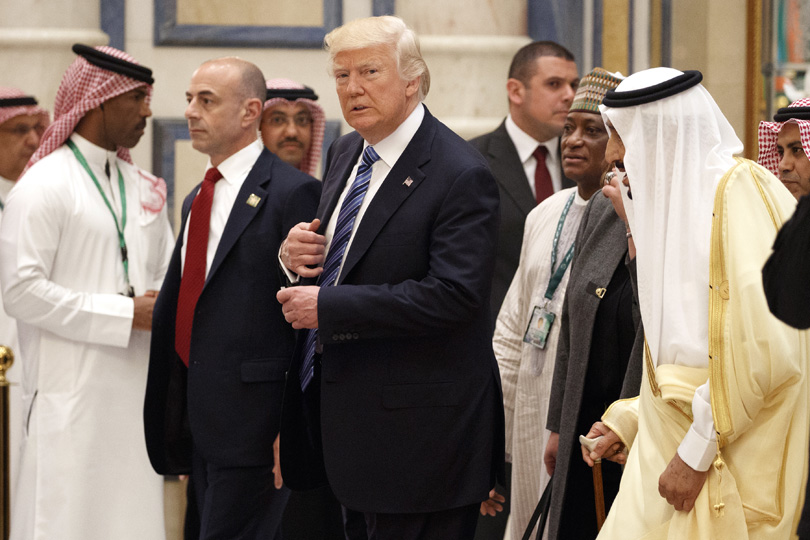CHRISTOPHER R. HILL
The recent six-month mark of Donald Trump’s presidency serves as a reminder not only of how little his administration has accomplished domestically, but also of how his meandering foreign policy has created a geopolitical landscape rife with ticking time bombs. And nowhere have the consequences of Trump’s almost willful incapacity to grasp complex problems, and his obsession with reversing the legacy of his predecessor, Barack Obama, become more apparent than in the Middle East.
Consider Trump’s decision in April to launch cruise missiles at the Shayrat Airbase in Syria, in response to the use of chemical weapons by Bashar al-Assad’s regime. Aside from an unconvincing nod to humanitarianism, Trump’s only rationale for deploying US military capabilities seems to have been that Obama – after famously drawing a “red line” against the use of chemical weapons in Syria – did not respond militarily to the Assad regime’s chemical attack in Ghouta in 2013.
But Trump showed little interest in following up on the attack with diplomacy. Then, earlier this month at the G20 summit in Hamburg, Germany, he indicated that the US might somehow join forces with Russia to enforce a ceasefire in Syria’s southwest, which would serve as a model for other parts of the country, thus setting the stage for an eventual peace process.
No one with even a cursory understanding of the situation in Syria could think that a peace process will emerge from a regional ceasefire. Assad’s government has been importing allies – Lebanon’s Hezbollah, Iran, Russia, and even Turkey (in some respects) – to fight on its behalf for years. The Syrian opposition, by contrast, has received only intermittent assistance, and remains as fragmented as it was when the civil war began.
No one knows what Trump has in mind in terms of Syria’s future borders or governance. In a fractured country with few civil-society institutions and many ethnic and religious groups, will minority rights be protected? What about its borders? If the world learned anything from Iraq, it is that democracy requires resilient institutions and effective governance, not just elections.
The Obama administration’s goal in Syria was to identify and support moderate rebel groups willing to fight Assad. The Trump administration, by contrast, has shut down military assistance to moderate opposition groups altogether, having apparently concluded that no such forces exist. It has offered tacit support for the peace talks currently underway in Astana, Kazakhstan, which were brokered by Iran, Turkey, and Russia. But it has given no indication that it will take the lead on a peace process of its own, or even try to influence the outcome of the Astana deliberations.
Judging by Trump’s first six months in office, one can safely assume that Assad will remain in power for the time being. Trump seems to be encountering the same problem that Obama did when he tried to explain to the American people that overthrowing Syria’s Alawite-dominated regime would help defeat Sunni extremist groups such as the Islamic State (ISIS). In fact, as many Syrians rightly fear, removing Assad without a clear idea of what comes next could pave the way for the emergence of a kind of radical “Sunni-stan.”
Islamic radicalism is largely a Sunni Arab phenomenon. It is not simply a consequence of abusive Shia or Alawite regimes in specific countries, and it will not suddenly disappear if those regimes do. After all, ISIS has other footholds in the region as far away as the Maghreb. Beyond Syria, Trump would prefer to think big. In May, when he attended a Gulf Cooperation Council (GCC) meeting in Riyadh, he praised Saudi Arabia as America’s top ally in the region. Given their disagreements with the Obama and George W. Bush administrations, the Saudis were eager for a new friend in the White House, and they greeted Trump by adorning Riyadh’s streets with massive posters of his visage.
During the GCC deliberations, Iran was singled out as the root cause of all the region’s problems (although the Saudis did invite Iraq which it often suggests is nothing but an Iranian surrogate). This anti-Iran rhetoric was certainly in keeping with Trump’s own. But Trump’s embrace of Saudi Arabia also seems to be about more than just Iran.
Many Trump supporters regard Saudi Arabia as the missing ingredient for Israeli-Palestinian peace. The Saudis have financial leverage over Fatah, the ruling Palestinian party in the West Bank, and they are open to marginalizing Hamas, the Islamist militia that rules in Gaza. Hamas receives support from the Muslim Brotherhood, an Islamist organization with extremist offshoots that is sometimes seen as a rival to the Saudi-grown Salafist movement.
By unconditionally embracing Saudi Arabia, Trump unwittingly set in motion a new public spat between that country and neighboring Qatar, which has long supported the Muslim Brotherhood. In June, Saudi Arabia, along with Egypt, the United Arab Emirates, and Bahrain, imposed a full-scale blockade on Qatar and issued its leaders a series of far-reaching demands.
The diplomatic dispute between Qatar – a strategically important country to the US – and the other Gulf states sent US Secretary of State Rex Tillerson into crisis mode. But Tillerson has distanced himself from Trump, and rumors are circulating in Washington that he already wants out.
If Trump intends to make his mark on the Middle East, he would do well to mind the region’s complexities, and not behave as if he were still campaigning against Obama or Hillary Clinton. To paraphrase Hippocrates, the first rule of diplomacy is to do no harm.







Comments